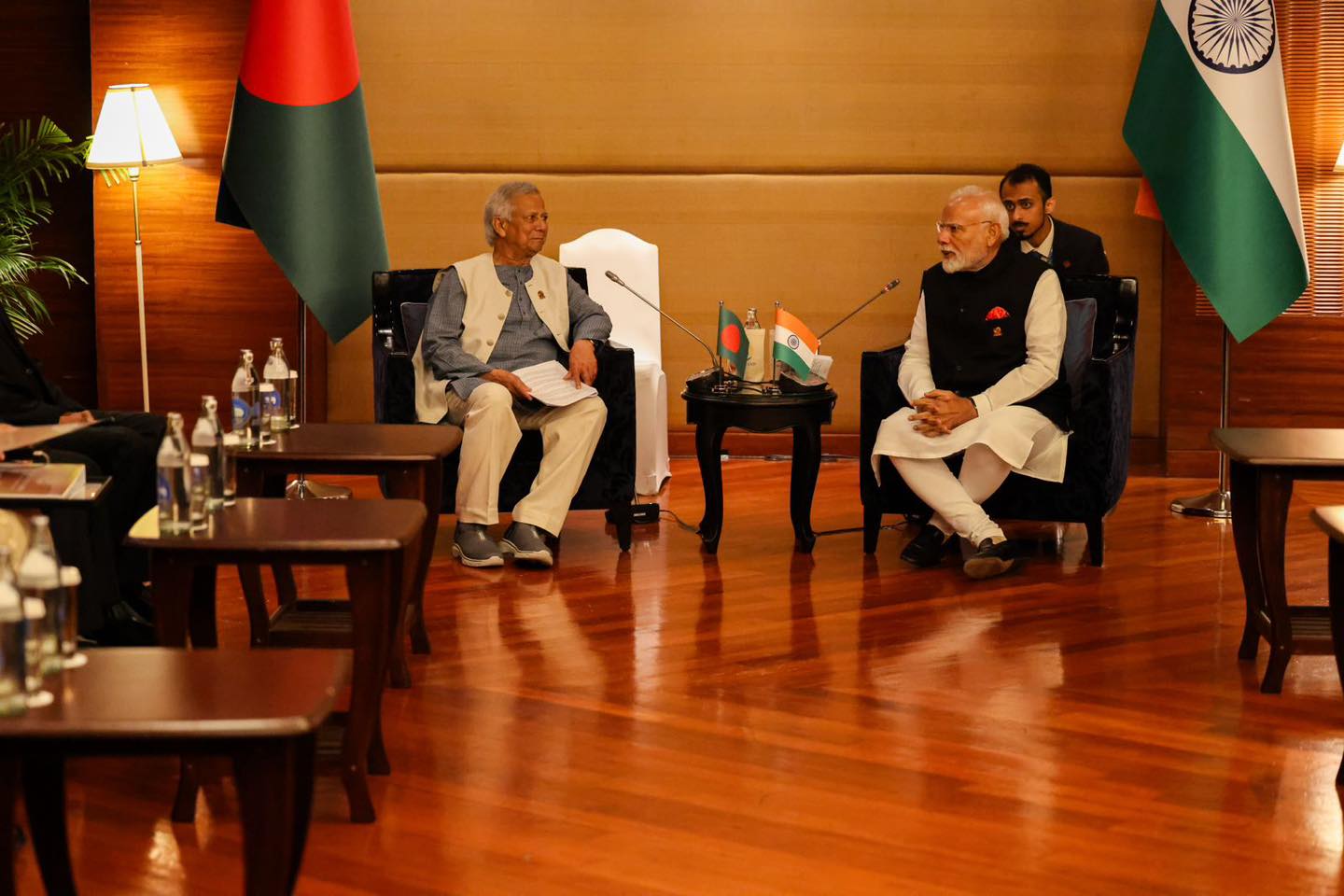
Nobel Laureate Dr. Muhammad Yunus has repeatedly emphasized the importance of regional cooperation for the economic self-reliance of South Asia.
Similarly, the World Bank has also stated that if India and Pakistan could move past their perpetual hostility and expand trade relations, they could achieve self-development without any external assistance.
The root cause of the enduring enmity between India and Pakistan lies in the mutual distrust and animosity between Hindus and Muslims – a colonial legacy left by the British that ended up portioning of India into Hindu Majority India (the present India) and Muslim majority Pakistan of which Bangladesh was once its part.
It’s astounding to think that the deep psychological affliction that has nurtured mutual hatred between the two communities, has endured to this day and kept these two countries, Hindu majority India and Muslim majority Pakistan at daggers drawn, into zones of division and deprivation.
The Mughals: India’s Muslim period
The British convinced the Hindus that the Mughals were oppressive rulers and that the British had come as just and fair administrators though at the time of fall of the Mughal empire, the Indian sub-continent boasted the highest, 26% of world’s GDP.
During Mughal time, Hindus held a significant number of high positions in the Mughal administration including in the Mughal army. Records suggest that the Mughals were the most inclusive rulers the world has ever witnessed. Both Hindus and Muslims received patronage in arts and culture.
No ruler in the history of the world has been a saint. But the measure of a ruler’s success lies in the economic development and the living standards of farmers and craftsmen under their rule. During the Mughal period, farmers and artisans, regardless of religion, were prosperous. Even British accounts describe the Mughal period of India, as the region where beggars were not seen.
India, now – a hate mongering society?
Recently, Indian politics has turned India’s 300-year-old history of peaceful co-habitation into a hate-land against Muslims.
From government policy to art and culture everything including the movies in India, a popular mass outreach, seem to be oriented towards hatred and persecution of Muslims.
For example, the recently released movie like Chhabba that portrayed distorted image of Muslims in this film is simply appalling if not inhuman.
The level of anti-Muslim sentiment entrenched in the Hindutva ideology is revealed in scene after scene. Chhabba is essentially an X-ray report of the Hindu subconscious in India. Unsurprisingly, it is a propaganda piece of the ruling BJP. After its release, BJP supporters have reportedly unleashed attacks on Muslim men and women.
In Chhabba, Muslims are consistently shown as ugly and barbaric; dark-skinned, heavily bearded, eyes lined with kohl, while Hindus are portrayed as graceful and impeccably dressed. The film starkly exposes the primitive mindset within the BJP’s inner circle, casually revealing the deep-seated communal biases that are nurtured from childhood in certain families.
Chhabba doesn’t just vilify Muslims, it practically fantasizes about Muslim extermination, presenting “101 ways” to kill Muslims. The imagined valor and heroism of Hindus portrayed in the film outshines even fairy tales. The film stands as a symbol of the communal hatred and bigotry that has festered in India’s subconscious during the 78 years of its independence. Watching Chhabba, one cannot help but wonder how the generation nurtured by the educational and cultural development of 20th-century India has come to accept and live in such a regressive, hate-driven society in the 21st century.
So where did things go wrong? How did such darkness accumulate under the very light of enlightenment claimed by the English-educated elites? Narendra Modi’s campaign of anti-Muslim violence that began in Gujarat has now spread throughout India, from Kashmir to Uttar Pradesh. The hatred is so deep that even having Muslim countries as neighbours is intolerable to some. When their much-anticipated “surgical strike” on Pakistan resulted in the crash of an Indian fighter jet, the fantasy of a heroic Mahabharata-like conquest stumbled hard. India’s inability to dominate Pakistan due to the deterrent of nuclear power has only deepened this frustration, making Pakistan an eternal enemy in the eyes of Hindutva forces. In the language of Indian Hindu nationalists, “Pakistan” has simply become a euphemism for “Muslim”. In India today, “Pakistan” sounds worse than saying “Muslim” when hurling abuse, hence Modi’s supporters use it freely.
Fall of Sheikh Hasina, India’s Shattered Colonial Dream and Vitriol: the Response of New Bangladesh
On August 5, 2024, when Sheikh Hasina’s autocratic regime in Bangladesh fell due to the July Revolution, India’s shadow colonial influence waned. As a result, Indian media shifted focus from Pakistan to Bangladesh. Now, Delhi’s South Block is constantly poking its nose into Bangladesh’s affairs. Dressed in the cloak of Hindutva, Indian diplomats like Veena Sikri and Riva Ganguly are busy spinning tales of “Khilafat in Bangladesh”, modern-day versions of the boy who cried wolf.
Over the past hundred years, an elite Bengali Hindu culture constructed during the British Raj’s Bengal Renaissance has been passed off as the thousand-year-old culture of Bangladesh. Consequently, many educated, and culturally inclined Bangladeshis have internalized a posture of deference toward the Indian state. It’s become a tradition for India to constantly meddle in Bangladesh’s internal affairs, while any comment on India’s own internal matters is considered taboo, a grave offense against the so-called progressive order.
For some inexplicable reason, India is seen as the sole guardian of Hindus in Bangladesh, and the Awami League plays the role of India’s local manager, carefully tallying Hindu votes and support. But why should any foreign power act as the guardian of Hindus, Muslims, Buddhists, Christians or Indigenous people in Bangladesh? Until now, no one has dared to ask India this question directly. In Bangladesh, Dr Yunus’ government is the first to do so. The July Revolution of 2024 marks the birth of a self-respecting Bangladesh.
Since August 5th, Indian officials and media have resumed their tired narrative about “minority oppression in Bangladesh.”
In a historic first, Dr Yunus’ press secretary Shafiqul Alam responded by raising concerns about the oppression of minorities in India.
Immediately, Bangladesh’s so-called cultural neo-elites; those uncles and aunties who deposited their spines in the so-called Bengal Renaissance archives in hopes of winning some sorry little award, began smirking at the “naivety” of the press secretary. Their dream is for someone like Pranab Mukherjee to send over a copy of Mohiner Ghoraguli and install a puppet government in Dhaka again, so that they can go back to their flute-playing days: “On this auspicious day, let’s go to the father’s home, to the palace of love.”
In economics there is a saying that if wishes were horses, beggars would ride.
Post July/August 2024 is a new Bangladesh, a Bangladesh of Gen Z who dreams of a democratic, just, inclusive and sovereign Bangladesh!
P.S.: In this piece, “India” refers to its power structures and their cohorts, the sectarian thugs. The common people of India are just as oppressed and marginalized as those in other South Asian countries. They deserve equal sympathy and solidarity.
Maskwaith Ahsan, Editor-In-Chief of E-SouthAsia , is a Writer, Journalist and Educator
